Liberty University: Test Anxiety and GPA of Community College Students
VerifiedAdded on 2022/08/20
|16
|4290
|13
Thesis and Dissertation
AI Summary
This dissertation investigates the effects of test anxiety on the GPA of community college students. The study employs a phenomenological approach, guided by the Conservation of Resources theory, to understand students' experiences with test anxiety. Data collection methods include face-to-face interviews, group focus, and telephone interviews. The research explores the historical, social, and theoretical contexts of test anxiety, including its impact on academic performance, emotional regulation, and dropout rates. Contributing factors such as poor test history, lack of preparation, and social pressures are examined. The study also highlights the role of attentional control theory in explaining how anxiety affects cognitive processes and the strategies to reduce test anxiety. The study aims to provide valuable insights into the challenges faced by community college students and contribute to the development of effective interventions to improve academic outcomes. The research also focuses on the factors such as the duration of the exam, the number of resources allocated to them and self-confidence and previous mental health issues. The common assessment tool for gaining an understanding of test anxiety include Cognitive Obstruction/Inattention subscale that assesses the obstructed cognition, Worry subscale that assesses the negative thoughts the anxiety.
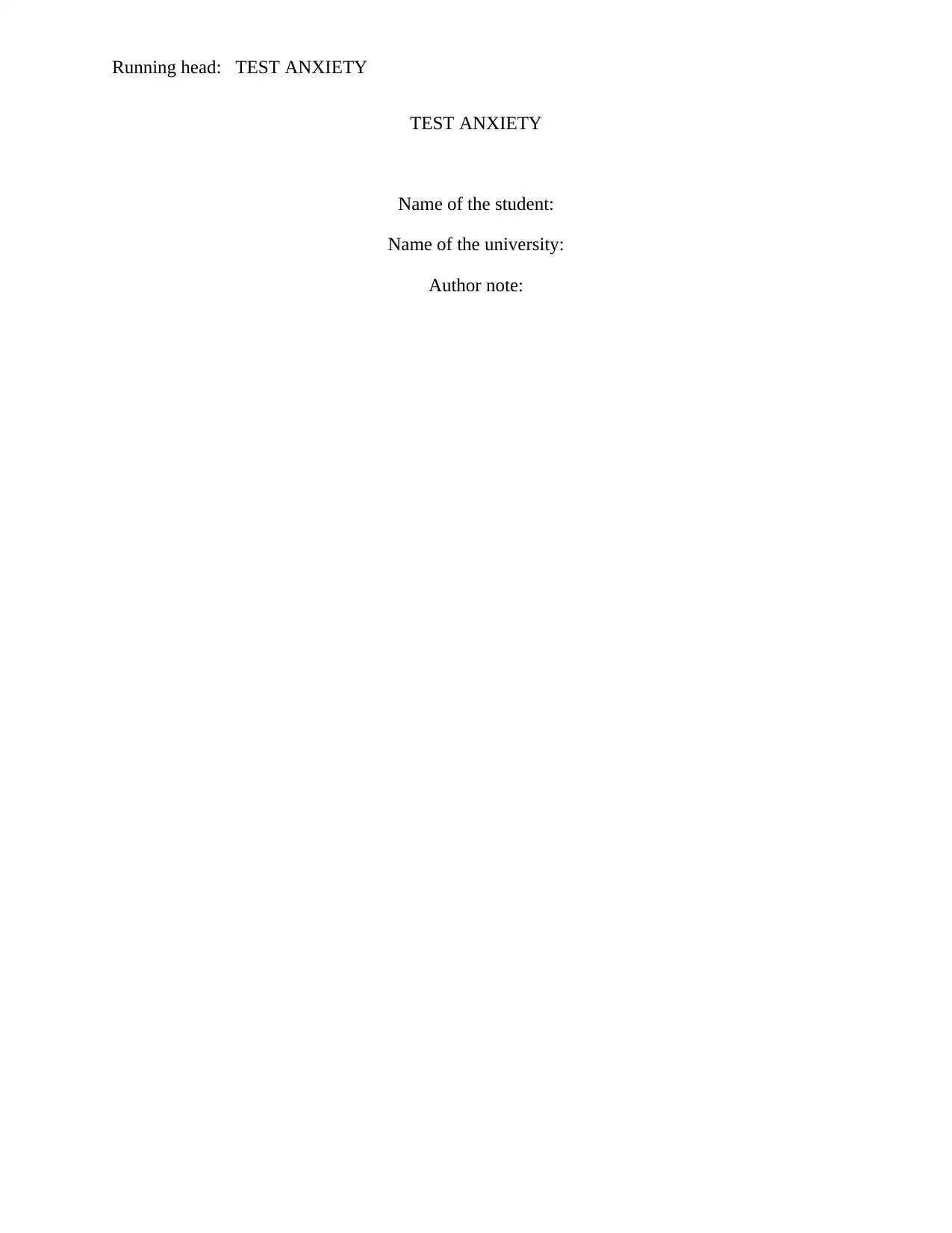
Running head: TEST ANXIETY
TEST ANXIETY
Name of the student:
Name of the university:
Author note:
TEST ANXIETY
Name of the student:
Name of the university:
Author note:
Paraphrase This Document
Need a fresh take? Get an instant paraphrase of this document with our AI Paraphraser
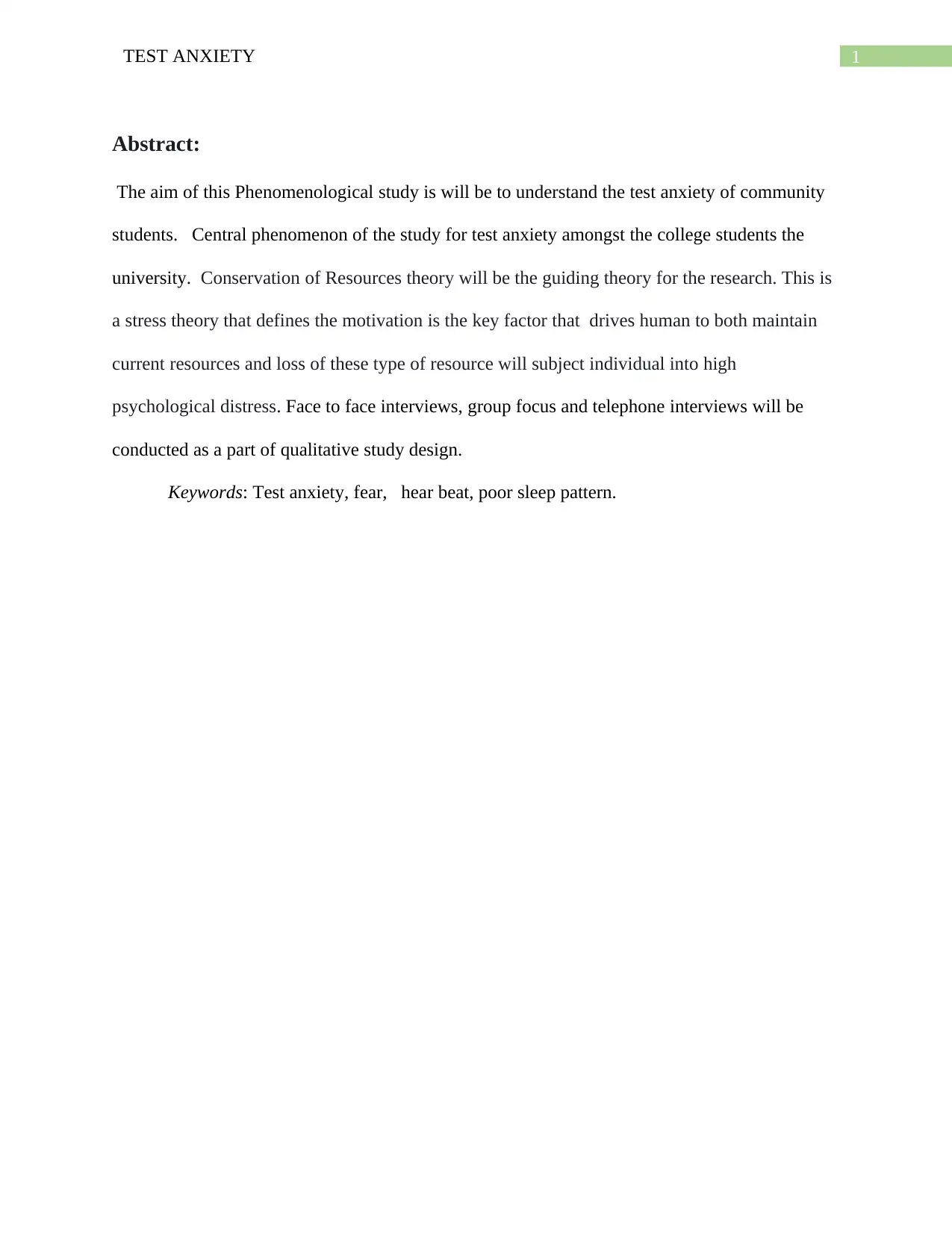
1TEST ANXIETY
Abstract:
The aim of this Phenomenological study is will be to understand the test anxiety of community
students. Central phenomenon of the study for test anxiety amongst the college students the
university. Conservation of Resources theory will be the guiding theory for the research. This is
a stress theory that defines the motivation is the key factor that drives human to both maintain
current resources and loss of these type of resource will subject individual into high
psychological distress. Face to face interviews, group focus and telephone interviews will be
conducted as a part of qualitative study design.
Keywords: Test anxiety, fear, hear beat, poor sleep pattern.
Abstract:
The aim of this Phenomenological study is will be to understand the test anxiety of community
students. Central phenomenon of the study for test anxiety amongst the college students the
university. Conservation of Resources theory will be the guiding theory for the research. This is
a stress theory that defines the motivation is the key factor that drives human to both maintain
current resources and loss of these type of resource will subject individual into high
psychological distress. Face to face interviews, group focus and telephone interviews will be
conducted as a part of qualitative study design.
Keywords: Test anxiety, fear, hear beat, poor sleep pattern.
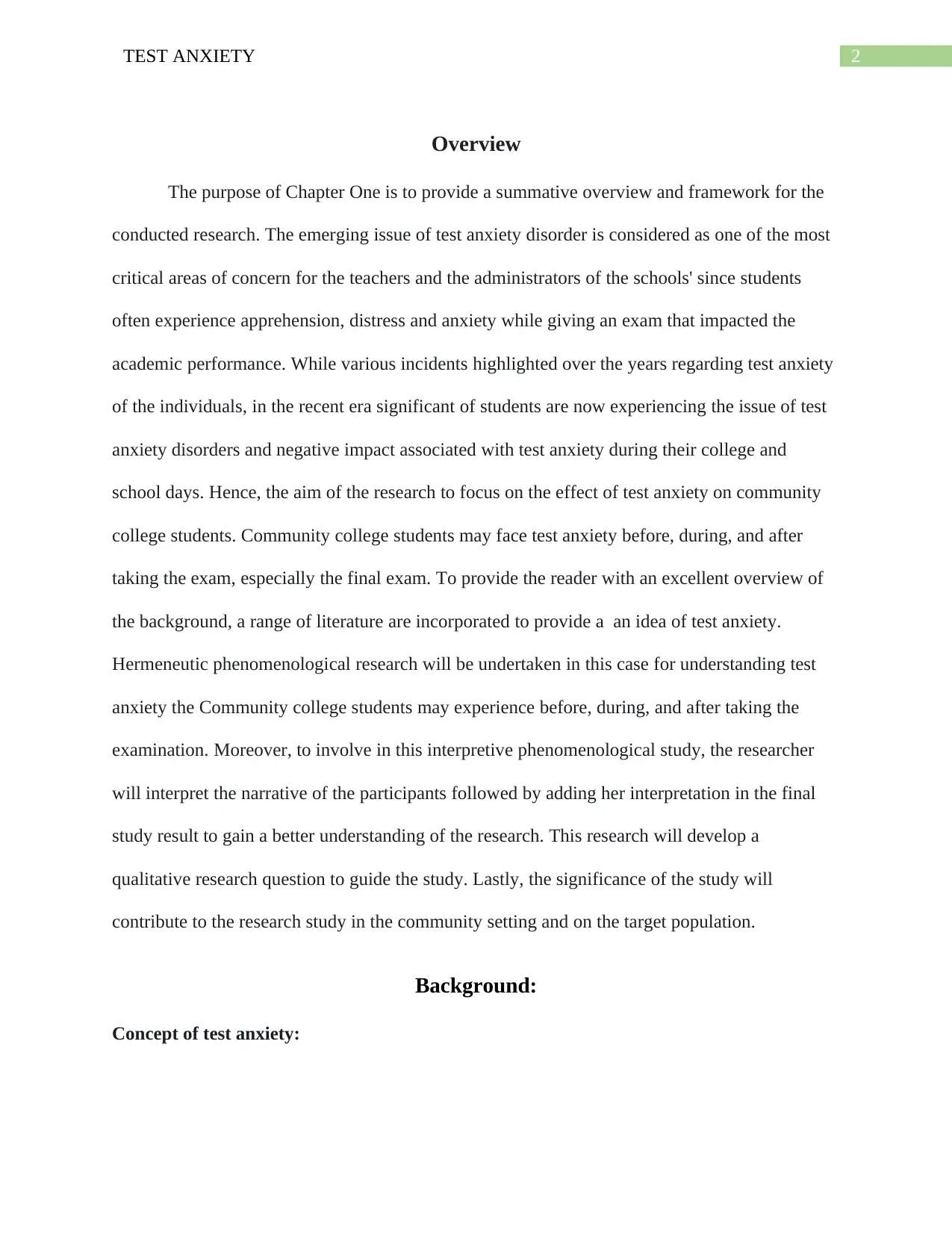
2TEST ANXIETY
Overview
The purpose of Chapter One is to provide a summative overview and framework for the
conducted research. The emerging issue of test anxiety disorder is considered as one of the most
critical areas of concern for the teachers and the administrators of the schools' since students
often experience apprehension, distress and anxiety while giving an exam that impacted the
academic performance. While various incidents highlighted over the years regarding test anxiety
of the individuals, in the recent era significant of students are now experiencing the issue of test
anxiety disorders and negative impact associated with test anxiety during their college and
school days. Hence, the aim of the research to focus on the effect of test anxiety on community
college students. Community college students may face test anxiety before, during, and after
taking the exam, especially the final exam. To provide the reader with an excellent overview of
the background, a range of literature are incorporated to provide a an idea of test anxiety.
Hermeneutic phenomenological research will be undertaken in this case for understanding test
anxiety the Community college students may experience before, during, and after taking the
examination. Moreover, to involve in this interpretive phenomenological study, the researcher
will interpret the narrative of the participants followed by adding her interpretation in the final
study result to gain a better understanding of the research. This research will develop a
qualitative research question to guide the study. Lastly, the significance of the study will
contribute to the research study in the community setting and on the target population.
Background:
Concept of test anxiety:
Overview
The purpose of Chapter One is to provide a summative overview and framework for the
conducted research. The emerging issue of test anxiety disorder is considered as one of the most
critical areas of concern for the teachers and the administrators of the schools' since students
often experience apprehension, distress and anxiety while giving an exam that impacted the
academic performance. While various incidents highlighted over the years regarding test anxiety
of the individuals, in the recent era significant of students are now experiencing the issue of test
anxiety disorders and negative impact associated with test anxiety during their college and
school days. Hence, the aim of the research to focus on the effect of test anxiety on community
college students. Community college students may face test anxiety before, during, and after
taking the exam, especially the final exam. To provide the reader with an excellent overview of
the background, a range of literature are incorporated to provide a an idea of test anxiety.
Hermeneutic phenomenological research will be undertaken in this case for understanding test
anxiety the Community college students may experience before, during, and after taking the
examination. Moreover, to involve in this interpretive phenomenological study, the researcher
will interpret the narrative of the participants followed by adding her interpretation in the final
study result to gain a better understanding of the research. This research will develop a
qualitative research question to guide the study. Lastly, the significance of the study will
contribute to the research study in the community setting and on the target population.
Background:
Concept of test anxiety:
⊘ This is a preview!⊘
Do you want full access?
Subscribe today to unlock all pages.

Trusted by 1+ million students worldwide
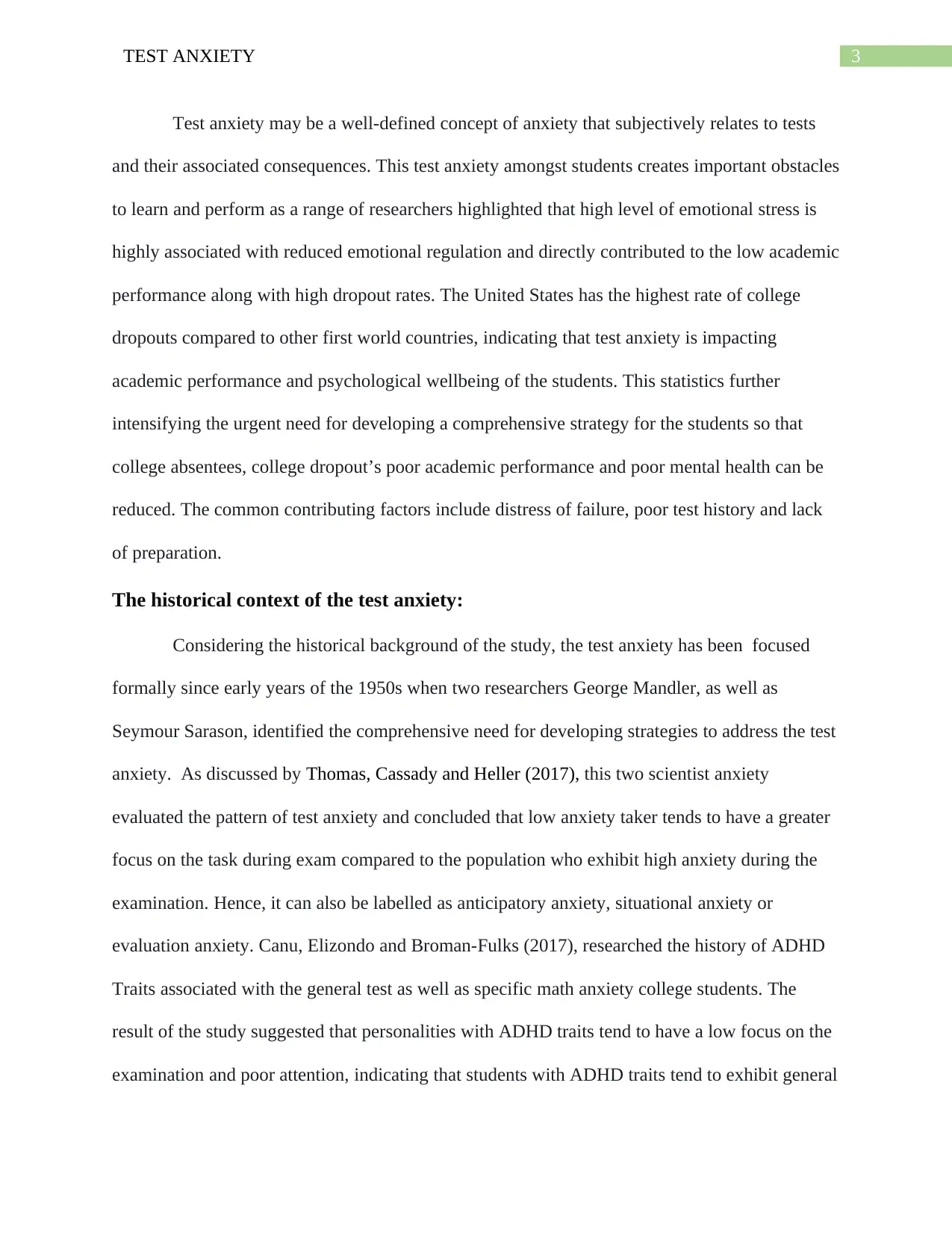
3TEST ANXIETY
Test anxiety may be a well-defined concept of anxiety that subjectively relates to tests
and their associated consequences. This test anxiety amongst students creates important obstacles
to learn and perform as a range of researchers highlighted that high level of emotional stress is
highly associated with reduced emotional regulation and directly contributed to the low academic
performance along with high dropout rates. The United States has the highest rate of college
dropouts compared to other first world countries, indicating that test anxiety is impacting
academic performance and psychological wellbeing of the students. This statistics further
intensifying the urgent need for developing a comprehensive strategy for the students so that
college absentees, college dropout’s poor academic performance and poor mental health can be
reduced. The common contributing factors include distress of failure, poor test history and lack
of preparation.
The historical context of the test anxiety:
Considering the historical background of the study, the test anxiety has been focused
formally since early years of the 1950s when two researchers George Mandler, as well as
Seymour Sarason, identified the comprehensive need for developing strategies to address the test
anxiety. As discussed by Thomas, Cassady and Heller (2017), this two scientist anxiety
evaluated the pattern of test anxiety and concluded that low anxiety taker tends to have a greater
focus on the task during exam compared to the population who exhibit high anxiety during the
examination. Hence, it can also be labelled as anticipatory anxiety, situational anxiety or
evaluation anxiety. Canu, Elizondo and Broman-Fulks (2017), researched the history of ADHD
Traits associated with the general test as well as specific math anxiety college students. The
result of the study suggested that personalities with ADHD traits tend to have a low focus on the
examination and poor attention, indicating that students with ADHD traits tend to exhibit general
Test anxiety may be a well-defined concept of anxiety that subjectively relates to tests
and their associated consequences. This test anxiety amongst students creates important obstacles
to learn and perform as a range of researchers highlighted that high level of emotional stress is
highly associated with reduced emotional regulation and directly contributed to the low academic
performance along with high dropout rates. The United States has the highest rate of college
dropouts compared to other first world countries, indicating that test anxiety is impacting
academic performance and psychological wellbeing of the students. This statistics further
intensifying the urgent need for developing a comprehensive strategy for the students so that
college absentees, college dropout’s poor academic performance and poor mental health can be
reduced. The common contributing factors include distress of failure, poor test history and lack
of preparation.
The historical context of the test anxiety:
Considering the historical background of the study, the test anxiety has been focused
formally since early years of the 1950s when two researchers George Mandler, as well as
Seymour Sarason, identified the comprehensive need for developing strategies to address the test
anxiety. As discussed by Thomas, Cassady and Heller (2017), this two scientist anxiety
evaluated the pattern of test anxiety and concluded that low anxiety taker tends to have a greater
focus on the task during exam compared to the population who exhibit high anxiety during the
examination. Hence, it can also be labelled as anticipatory anxiety, situational anxiety or
evaluation anxiety. Canu, Elizondo and Broman-Fulks (2017), researched the history of ADHD
Traits associated with the general test as well as specific math anxiety college students. The
result of the study suggested that personalities with ADHD traits tend to have a low focus on the
examination and poor attention, indicating that students with ADHD traits tend to exhibit general
Paraphrase This Document
Need a fresh take? Get an instant paraphrase of this document with our AI Paraphraser
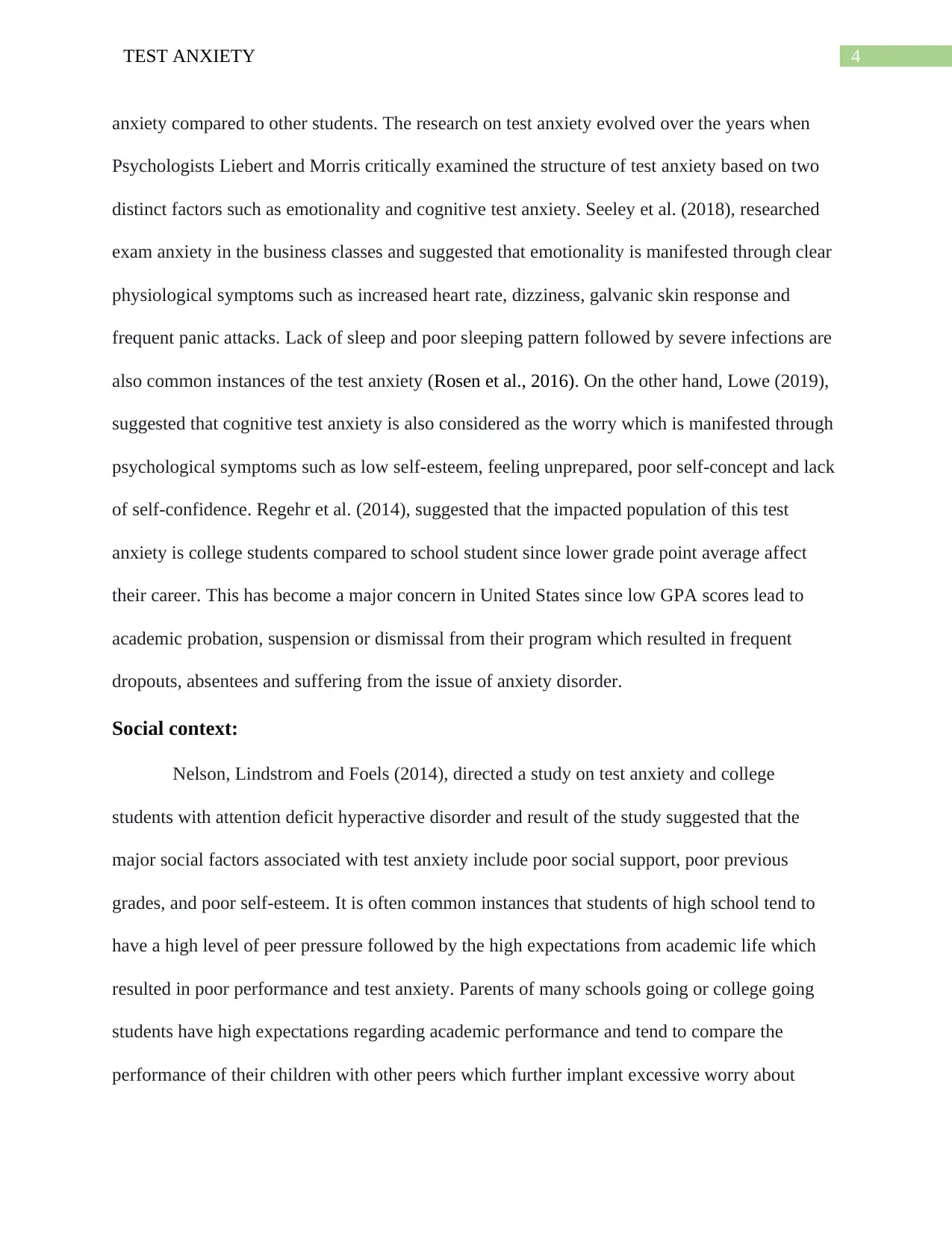
4TEST ANXIETY
anxiety compared to other students. The research on test anxiety evolved over the years when
Psychologists Liebert and Morris critically examined the structure of test anxiety based on two
distinct factors such as emotionality and cognitive test anxiety. Seeley et al. (2018), researched
exam anxiety in the business classes and suggested that emotionality is manifested through clear
physiological symptoms such as increased heart rate, dizziness, galvanic skin response and
frequent panic attacks. Lack of sleep and poor sleeping pattern followed by severe infections are
also common instances of the test anxiety (Rosen et al., 2016). On the other hand, Lowe (2019),
suggested that cognitive test anxiety is also considered as the worry which is manifested through
psychological symptoms such as low self-esteem, feeling unprepared, poor self-concept and lack
of self-confidence. Regehr et al. (2014), suggested that the impacted population of this test
anxiety is college students compared to school student since lower grade point average affect
their career. This has become a major concern in United States since low GPA scores lead to
academic probation, suspension or dismissal from their program which resulted in frequent
dropouts, absentees and suffering from the issue of anxiety disorder.
Social context:
Nelson, Lindstrom and Foels (2014), directed a study on test anxiety and college
students with attention deficit hyperactive disorder and result of the study suggested that the
major social factors associated with test anxiety include poor social support, poor previous
grades, and poor self-esteem. It is often common instances that students of high school tend to
have a high level of peer pressure followed by the high expectations from academic life which
resulted in poor performance and test anxiety. Parents of many schools going or college going
students have high expectations regarding academic performance and tend to compare the
performance of their children with other peers which further implant excessive worry about
anxiety compared to other students. The research on test anxiety evolved over the years when
Psychologists Liebert and Morris critically examined the structure of test anxiety based on two
distinct factors such as emotionality and cognitive test anxiety. Seeley et al. (2018), researched
exam anxiety in the business classes and suggested that emotionality is manifested through clear
physiological symptoms such as increased heart rate, dizziness, galvanic skin response and
frequent panic attacks. Lack of sleep and poor sleeping pattern followed by severe infections are
also common instances of the test anxiety (Rosen et al., 2016). On the other hand, Lowe (2019),
suggested that cognitive test anxiety is also considered as the worry which is manifested through
psychological symptoms such as low self-esteem, feeling unprepared, poor self-concept and lack
of self-confidence. Regehr et al. (2014), suggested that the impacted population of this test
anxiety is college students compared to school student since lower grade point average affect
their career. This has become a major concern in United States since low GPA scores lead to
academic probation, suspension or dismissal from their program which resulted in frequent
dropouts, absentees and suffering from the issue of anxiety disorder.
Social context:
Nelson, Lindstrom and Foels (2014), directed a study on test anxiety and college
students with attention deficit hyperactive disorder and result of the study suggested that the
major social factors associated with test anxiety include poor social support, poor previous
grades, and poor self-esteem. It is often common instances that students of high school tend to
have a high level of peer pressure followed by the high expectations from academic life which
resulted in poor performance and test anxiety. Parents of many schools going or college going
students have high expectations regarding academic performance and tend to compare the
performance of their children with other peers which further implant excessive worry about
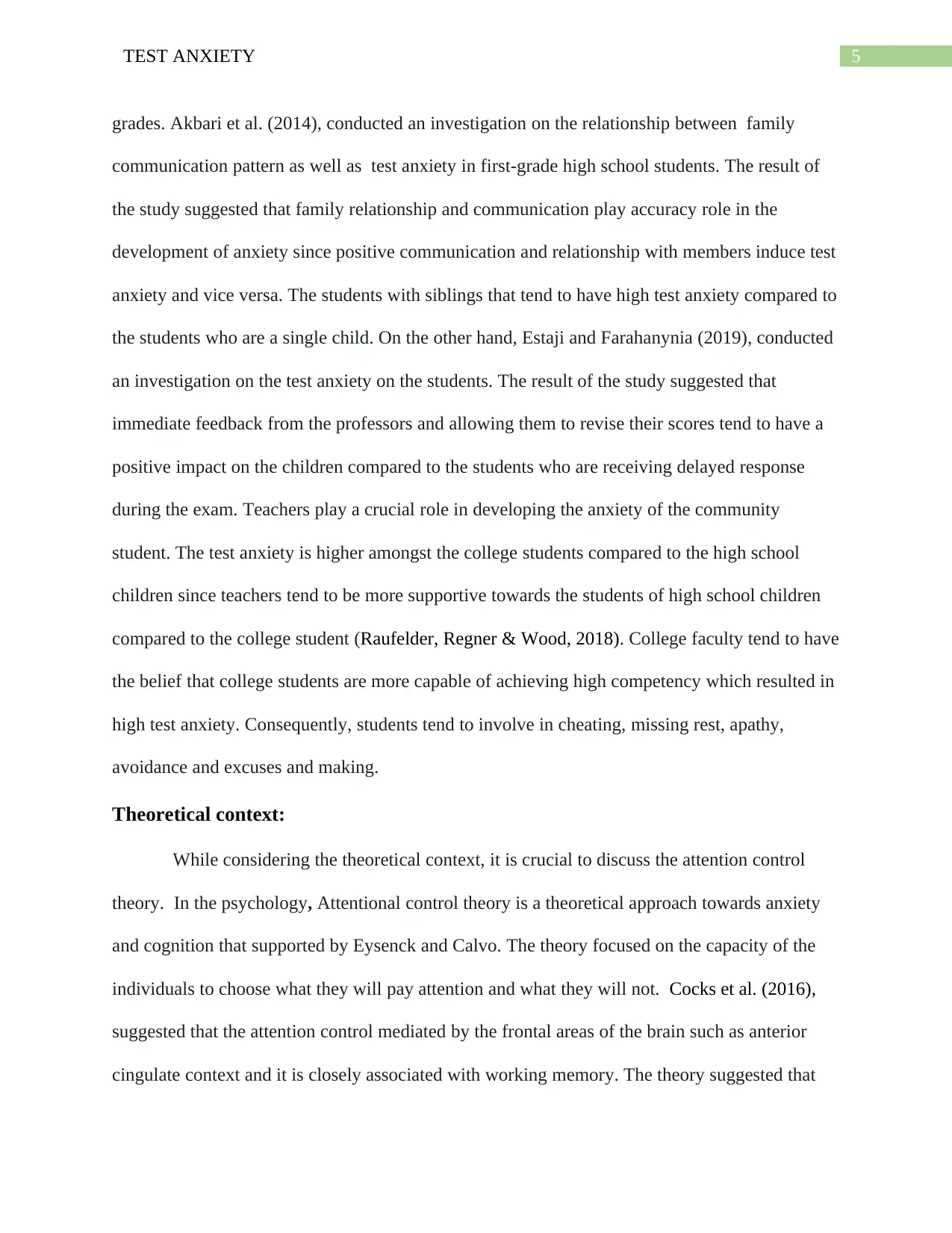
5TEST ANXIETY
grades. Akbari et al. (2014), conducted an investigation on the relationship between family
communication pattern as well as test anxiety in first-grade high school students. The result of
the study suggested that family relationship and communication play accuracy role in the
development of anxiety since positive communication and relationship with members induce test
anxiety and vice versa. The students with siblings that tend to have high test anxiety compared to
the students who are a single child. On the other hand, Estaji and Farahanynia (2019), conducted
an investigation on the test anxiety on the students. The result of the study suggested that
immediate feedback from the professors and allowing them to revise their scores tend to have a
positive impact on the children compared to the students who are receiving delayed response
during the exam. Teachers play a crucial role in developing the anxiety of the community
student. The test anxiety is higher amongst the college students compared to the high school
children since teachers tend to be more supportive towards the students of high school children
compared to the college student (Raufelder, Regner & Wood, 2018). College faculty tend to have
the belief that college students are more capable of achieving high competency which resulted in
high test anxiety. Consequently, students tend to involve in cheating, missing rest, apathy,
avoidance and excuses and making.
Theoretical context:
While considering the theoretical context, it is crucial to discuss the attention control
theory. In the psychology, Attentional control theory is a theoretical approach towards anxiety
and cognition that supported by Eysenck and Calvo. The theory focused on the capacity of the
individuals to choose what they will pay attention and what they will not. Cocks et al. (2016),
suggested that the attention control mediated by the frontal areas of the brain such as anterior
cingulate context and it is closely associated with working memory. The theory suggested that
grades. Akbari et al. (2014), conducted an investigation on the relationship between family
communication pattern as well as test anxiety in first-grade high school students. The result of
the study suggested that family relationship and communication play accuracy role in the
development of anxiety since positive communication and relationship with members induce test
anxiety and vice versa. The students with siblings that tend to have high test anxiety compared to
the students who are a single child. On the other hand, Estaji and Farahanynia (2019), conducted
an investigation on the test anxiety on the students. The result of the study suggested that
immediate feedback from the professors and allowing them to revise their scores tend to have a
positive impact on the children compared to the students who are receiving delayed response
during the exam. Teachers play a crucial role in developing the anxiety of the community
student. The test anxiety is higher amongst the college students compared to the high school
children since teachers tend to be more supportive towards the students of high school children
compared to the college student (Raufelder, Regner & Wood, 2018). College faculty tend to have
the belief that college students are more capable of achieving high competency which resulted in
high test anxiety. Consequently, students tend to involve in cheating, missing rest, apathy,
avoidance and excuses and making.
Theoretical context:
While considering the theoretical context, it is crucial to discuss the attention control
theory. In the psychology, Attentional control theory is a theoretical approach towards anxiety
and cognition that supported by Eysenck and Calvo. The theory focused on the capacity of the
individuals to choose what they will pay attention and what they will not. Cocks et al. (2016),
suggested that the attention control mediated by the frontal areas of the brain such as anterior
cingulate context and it is closely associated with working memory. The theory suggested that
⊘ This is a preview!⊘
Do you want full access?
Subscribe today to unlock all pages.

Trusted by 1+ million students worldwide
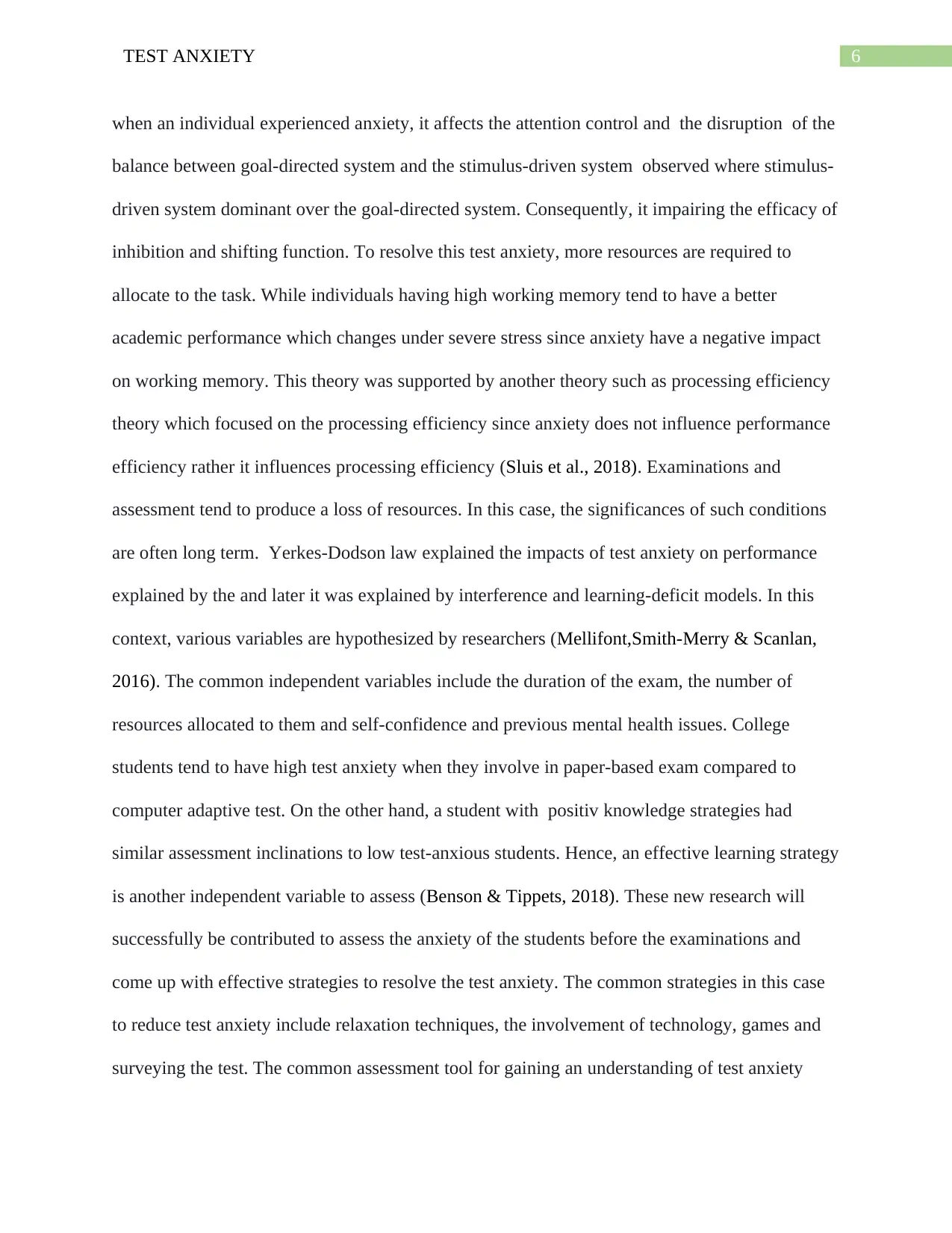
6TEST ANXIETY
when an individual experienced anxiety, it affects the attention control and the disruption of the
balance between goal-directed system and the stimulus-driven system observed where stimulus-
driven system dominant over the goal-directed system. Consequently, it impairing the efficacy of
inhibition and shifting function. To resolve this test anxiety, more resources are required to
allocate to the task. While individuals having high working memory tend to have a better
academic performance which changes under severe stress since anxiety have a negative impact
on working memory. This theory was supported by another theory such as processing efficiency
theory which focused on the processing efficiency since anxiety does not influence performance
efficiency rather it influences processing efficiency (Sluis et al., 2018). Examinations and
assessment tend to produce a loss of resources. In this case, the significances of such conditions
are often long term. Yerkes-Dodson law explained the impacts of test anxiety on performance
explained by the and later it was explained by interference and learning-deficit models. In this
context, various variables are hypothesized by researchers (Mellifont,Smith-Merry & Scanlan,
2016). The common independent variables include the duration of the exam, the number of
resources allocated to them and self-confidence and previous mental health issues. College
students tend to have high test anxiety when they involve in paper-based exam compared to
computer adaptive test. On the other hand, a student with positiv knowledge strategies had
similar assessment inclinations to low test-anxious students. Hence, an effective learning strategy
is another independent variable to assess (Benson & Tippets, 2018). These new research will
successfully be contributed to assess the anxiety of the students before the examinations and
come up with effective strategies to resolve the test anxiety. The common strategies in this case
to reduce test anxiety include relaxation techniques, the involvement of technology, games and
surveying the test. The common assessment tool for gaining an understanding of test anxiety
when an individual experienced anxiety, it affects the attention control and the disruption of the
balance between goal-directed system and the stimulus-driven system observed where stimulus-
driven system dominant over the goal-directed system. Consequently, it impairing the efficacy of
inhibition and shifting function. To resolve this test anxiety, more resources are required to
allocate to the task. While individuals having high working memory tend to have a better
academic performance which changes under severe stress since anxiety have a negative impact
on working memory. This theory was supported by another theory such as processing efficiency
theory which focused on the processing efficiency since anxiety does not influence performance
efficiency rather it influences processing efficiency (Sluis et al., 2018). Examinations and
assessment tend to produce a loss of resources. In this case, the significances of such conditions
are often long term. Yerkes-Dodson law explained the impacts of test anxiety on performance
explained by the and later it was explained by interference and learning-deficit models. In this
context, various variables are hypothesized by researchers (Mellifont,Smith-Merry & Scanlan,
2016). The common independent variables include the duration of the exam, the number of
resources allocated to them and self-confidence and previous mental health issues. College
students tend to have high test anxiety when they involve in paper-based exam compared to
computer adaptive test. On the other hand, a student with positiv knowledge strategies had
similar assessment inclinations to low test-anxious students. Hence, an effective learning strategy
is another independent variable to assess (Benson & Tippets, 2018). These new research will
successfully be contributed to assess the anxiety of the students before the examinations and
come up with effective strategies to resolve the test anxiety. The common strategies in this case
to reduce test anxiety include relaxation techniques, the involvement of technology, games and
surveying the test. The common assessment tool for gaining an understanding of test anxiety
Paraphrase This Document
Need a fresh take? Get an instant paraphrase of this document with our AI Paraphraser
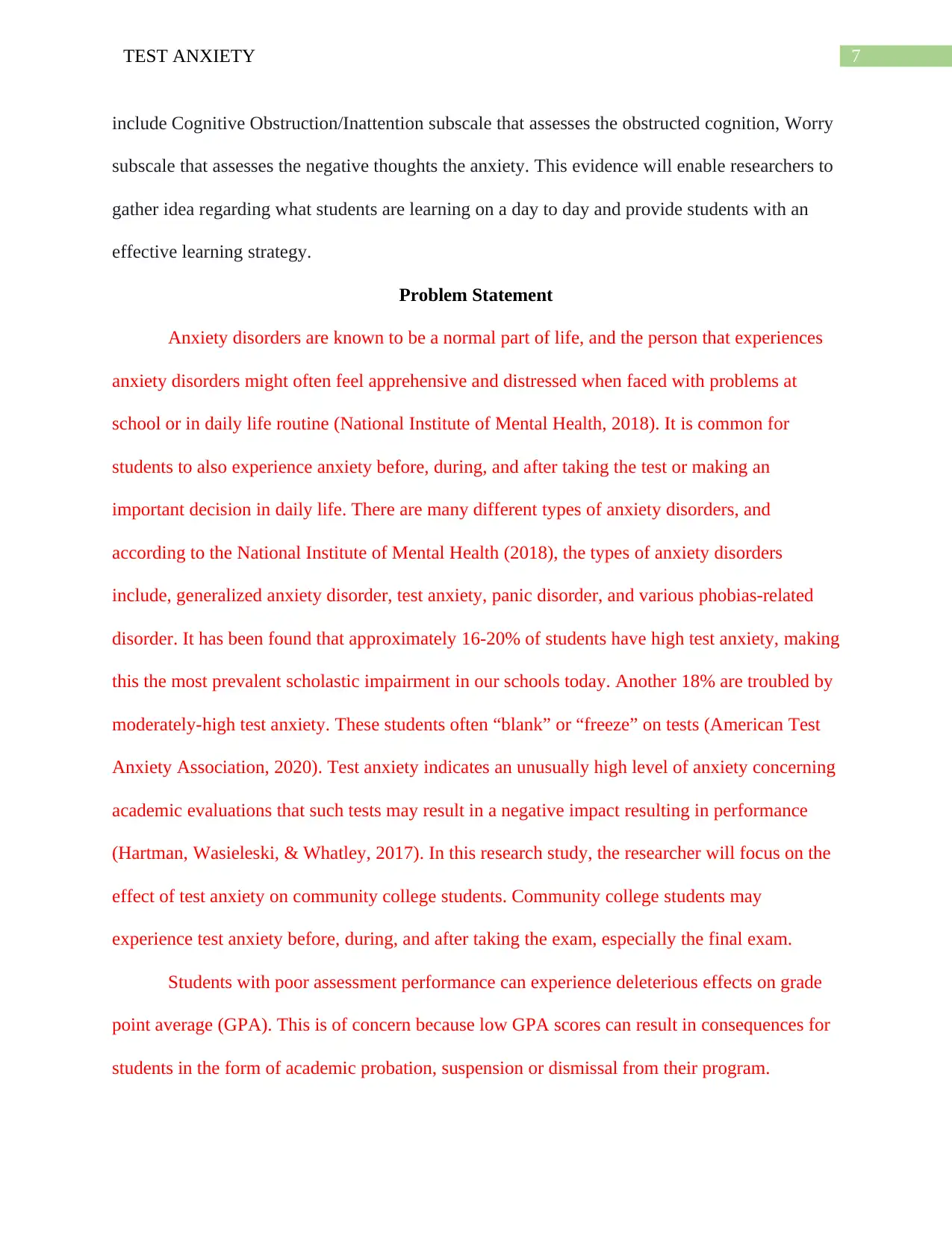
7TEST ANXIETY
include Cognitive Obstruction/Inattention subscale that assesses the obstructed cognition, Worry
subscale that assesses the negative thoughts the anxiety. This evidence will enable researchers to
gather idea regarding what students are learning on a day to day and provide students with an
effective learning strategy.
Problem Statement
Anxiety disorders are known to be a normal part of life, and the person that experiences
anxiety disorders might often feel apprehensive and distressed when faced with problems at
school or in daily life routine (National Institute of Mental Health, 2018). It is common for
students to also experience anxiety before, during, and after taking the test or making an
important decision in daily life. There are many different types of anxiety disorders, and
according to the National Institute of Mental Health (2018), the types of anxiety disorders
include, generalized anxiety disorder, test anxiety, panic disorder, and various phobias-related
disorder. It has been found that approximately 16-20% of students have high test anxiety, making
this the most prevalent scholastic impairment in our schools today. Another 18% are troubled by
moderately-high test anxiety. These students often “blank” or “freeze” on tests (American Test
Anxiety Association, 2020). Test anxiety indicates an unusually high level of anxiety concerning
academic evaluations that such tests may result in a negative impact resulting in performance
(Hartman, Wasieleski, & Whatley, 2017). In this research study, the researcher will focus on the
effect of test anxiety on community college students. Community college students may
experience test anxiety before, during, and after taking the exam, especially the final exam.
Students with poor assessment performance can experience deleterious effects on grade
point average (GPA). This is of concern because low GPA scores can result in consequences for
students in the form of academic probation, suspension or dismissal from their program.
include Cognitive Obstruction/Inattention subscale that assesses the obstructed cognition, Worry
subscale that assesses the negative thoughts the anxiety. This evidence will enable researchers to
gather idea regarding what students are learning on a day to day and provide students with an
effective learning strategy.
Problem Statement
Anxiety disorders are known to be a normal part of life, and the person that experiences
anxiety disorders might often feel apprehensive and distressed when faced with problems at
school or in daily life routine (National Institute of Mental Health, 2018). It is common for
students to also experience anxiety before, during, and after taking the test or making an
important decision in daily life. There are many different types of anxiety disorders, and
according to the National Institute of Mental Health (2018), the types of anxiety disorders
include, generalized anxiety disorder, test anxiety, panic disorder, and various phobias-related
disorder. It has been found that approximately 16-20% of students have high test anxiety, making
this the most prevalent scholastic impairment in our schools today. Another 18% are troubled by
moderately-high test anxiety. These students often “blank” or “freeze” on tests (American Test
Anxiety Association, 2020). Test anxiety indicates an unusually high level of anxiety concerning
academic evaluations that such tests may result in a negative impact resulting in performance
(Hartman, Wasieleski, & Whatley, 2017). In this research study, the researcher will focus on the
effect of test anxiety on community college students. Community college students may
experience test anxiety before, during, and after taking the exam, especially the final exam.
Students with poor assessment performance can experience deleterious effects on grade
point average (GPA). This is of concern because low GPA scores can result in consequences for
students in the form of academic probation, suspension or dismissal from their program.
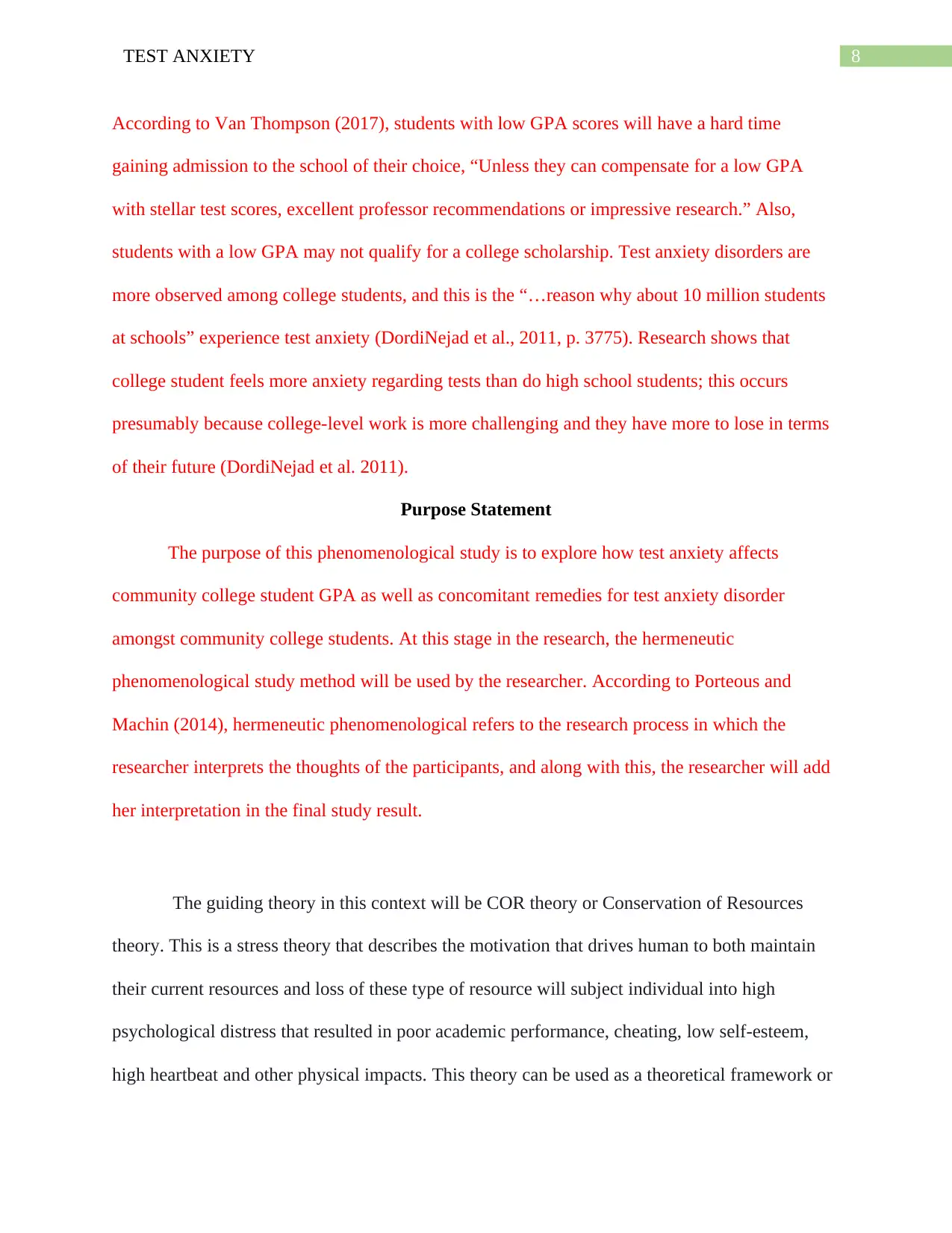
8TEST ANXIETY
According to Van Thompson (2017), students with low GPA scores will have a hard time
gaining admission to the school of their choice, “Unless they can compensate for a low GPA
with stellar test scores, excellent professor recommendations or impressive research.” Also,
students with a low GPA may not qualify for a college scholarship. Test anxiety disorders are
more observed among college students, and this is the “…reason why about 10 million students
at schools” experience test anxiety (DordiNejad et al., 2011, p. 3775). Research shows that
college student feels more anxiety regarding tests than do high school students; this occurs
presumably because college-level work is more challenging and they have more to lose in terms
of their future (DordiNejad et al. 2011).
Purpose Statement
The purpose of this phenomenological study is to explore how test anxiety affects
community college student GPA as well as concomitant remedies for test anxiety disorder
amongst community college students. At this stage in the research, the hermeneutic
phenomenological study method will be used by the researcher. According to Porteous and
Machin (2014), hermeneutic phenomenological refers to the research process in which the
researcher interprets the thoughts of the participants, and along with this, the researcher will add
her interpretation in the final study result.
The guiding theory in this context will be COR theory or Conservation of Resources
theory. This is a stress theory that describes the motivation that drives human to both maintain
their current resources and loss of these type of resource will subject individual into high
psychological distress that resulted in poor academic performance, cheating, low self-esteem,
high heartbeat and other physical impacts. This theory can be used as a theoretical framework or
According to Van Thompson (2017), students with low GPA scores will have a hard time
gaining admission to the school of their choice, “Unless they can compensate for a low GPA
with stellar test scores, excellent professor recommendations or impressive research.” Also,
students with a low GPA may not qualify for a college scholarship. Test anxiety disorders are
more observed among college students, and this is the “…reason why about 10 million students
at schools” experience test anxiety (DordiNejad et al., 2011, p. 3775). Research shows that
college student feels more anxiety regarding tests than do high school students; this occurs
presumably because college-level work is more challenging and they have more to lose in terms
of their future (DordiNejad et al. 2011).
Purpose Statement
The purpose of this phenomenological study is to explore how test anxiety affects
community college student GPA as well as concomitant remedies for test anxiety disorder
amongst community college students. At this stage in the research, the hermeneutic
phenomenological study method will be used by the researcher. According to Porteous and
Machin (2014), hermeneutic phenomenological refers to the research process in which the
researcher interprets the thoughts of the participants, and along with this, the researcher will add
her interpretation in the final study result.
The guiding theory in this context will be COR theory or Conservation of Resources
theory. This is a stress theory that describes the motivation that drives human to both maintain
their current resources and loss of these type of resource will subject individual into high
psychological distress that resulted in poor academic performance, cheating, low self-esteem,
high heartbeat and other physical impacts. This theory can be used as a theoretical framework or
⊘ This is a preview!⊘
Do you want full access?
Subscribe today to unlock all pages.

Trusted by 1+ million students worldwide
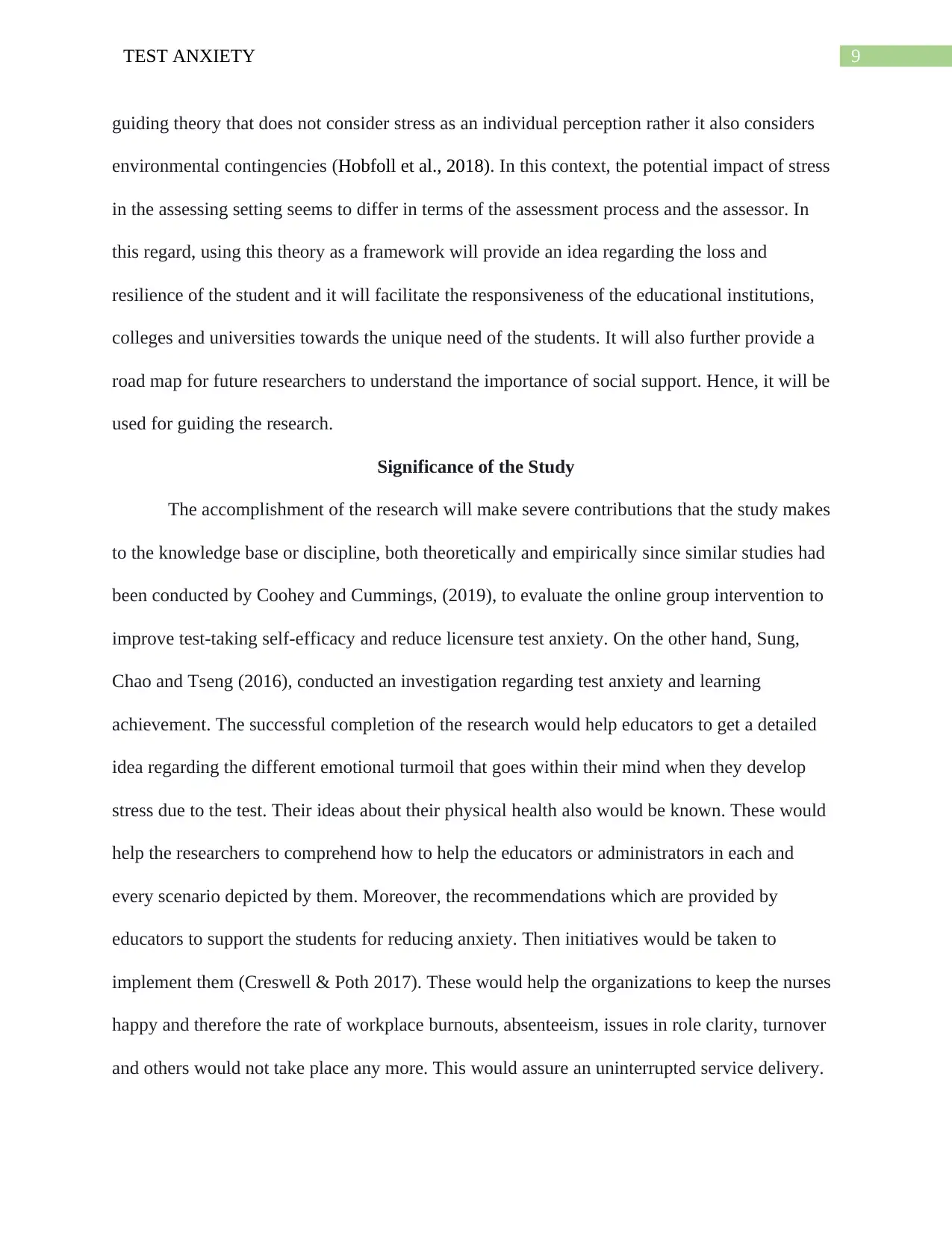
9TEST ANXIETY
guiding theory that does not consider stress as an individual perception rather it also considers
environmental contingencies (Hobfoll et al., 2018). In this context, the potential impact of stress
in the assessing setting seems to differ in terms of the assessment process and the assessor. In
this regard, using this theory as a framework will provide an idea regarding the loss and
resilience of the student and it will facilitate the responsiveness of the educational institutions,
colleges and universities towards the unique need of the students. It will also further provide a
road map for future researchers to understand the importance of social support. Hence, it will be
used for guiding the research.
Significance of the Study
The accomplishment of the research will make severe contributions that the study makes
to the knowledge base or discipline, both theoretically and empirically since similar studies had
been conducted by Coohey and Cummings, (2019), to evaluate the online group intervention to
improve test-taking self-efficacy and reduce licensure test anxiety. On the other hand, Sung,
Chao and Tseng (2016), conducted an investigation regarding test anxiety and learning
achievement. The successful completion of the research would help educators to get a detailed
idea regarding the different emotional turmoil that goes within their mind when they develop
stress due to the test. Their ideas about their physical health also would be known. These would
help the researchers to comprehend how to help the educators or administrators in each and
every scenario depicted by them. Moreover, the recommendations which are provided by
educators to support the students for reducing anxiety. Then initiatives would be taken to
implement them (Creswell & Poth 2017). These would help the organizations to keep the nurses
happy and therefore the rate of workplace burnouts, absenteeism, issues in role clarity, turnover
and others would not take place any more. This would assure an uninterrupted service delivery.
guiding theory that does not consider stress as an individual perception rather it also considers
environmental contingencies (Hobfoll et al., 2018). In this context, the potential impact of stress
in the assessing setting seems to differ in terms of the assessment process and the assessor. In
this regard, using this theory as a framework will provide an idea regarding the loss and
resilience of the student and it will facilitate the responsiveness of the educational institutions,
colleges and universities towards the unique need of the students. It will also further provide a
road map for future researchers to understand the importance of social support. Hence, it will be
used for guiding the research.
Significance of the Study
The accomplishment of the research will make severe contributions that the study makes
to the knowledge base or discipline, both theoretically and empirically since similar studies had
been conducted by Coohey and Cummings, (2019), to evaluate the online group intervention to
improve test-taking self-efficacy and reduce licensure test anxiety. On the other hand, Sung,
Chao and Tseng (2016), conducted an investigation regarding test anxiety and learning
achievement. The successful completion of the research would help educators to get a detailed
idea regarding the different emotional turmoil that goes within their mind when they develop
stress due to the test. Their ideas about their physical health also would be known. These would
help the researchers to comprehend how to help the educators or administrators in each and
every scenario depicted by them. Moreover, the recommendations which are provided by
educators to support the students for reducing anxiety. Then initiatives would be taken to
implement them (Creswell & Poth 2017). These would help the organizations to keep the nurses
happy and therefore the rate of workplace burnouts, absenteeism, issues in role clarity, turnover
and others would not take place any more. This would assure an uninterrupted service delivery.
Paraphrase This Document
Need a fresh take? Get an instant paraphrase of this document with our AI Paraphraser
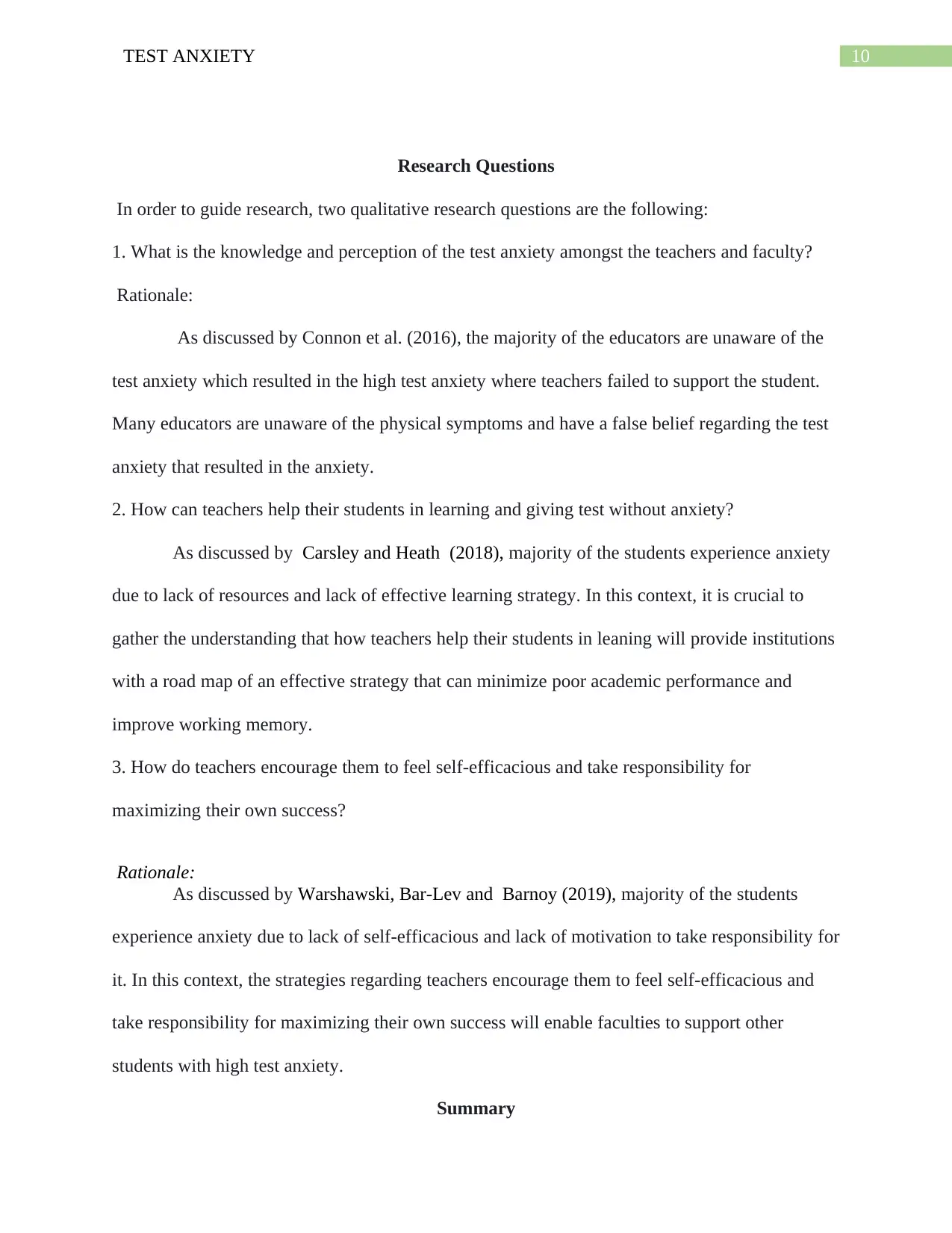
10TEST ANXIETY
Research Questions
In order to guide research, two qualitative research questions are the following:
1. What is the knowledge and perception of the test anxiety amongst the teachers and faculty?
Rationale:
As discussed by Connon et al. (2016), the majority of the educators are unaware of the
test anxiety which resulted in the high test anxiety where teachers failed to support the student.
Many educators are unaware of the physical symptoms and have a false belief regarding the test
anxiety that resulted in the anxiety.
2. How can teachers help their students in learning and giving test without anxiety?
As discussed by Carsley and Heath (2018), majority of the students experience anxiety
due to lack of resources and lack of effective learning strategy. In this context, it is crucial to
gather the understanding that how teachers help their students in leaning will provide institutions
with a road map of an effective strategy that can minimize poor academic performance and
improve working memory.
3. How do teachers encourage them to feel self-efficacious and take responsibility for
maximizing their own success?
Rationale:
As discussed by Warshawski, Bar-Lev and Barnoy (2019), majority of the students
experience anxiety due to lack of self-efficacious and lack of motivation to take responsibility for
it. In this context, the strategies regarding teachers encourage them to feel self-efficacious and
take responsibility for maximizing their own success will enable faculties to support other
students with high test anxiety.
Summary
Research Questions
In order to guide research, two qualitative research questions are the following:
1. What is the knowledge and perception of the test anxiety amongst the teachers and faculty?
Rationale:
As discussed by Connon et al. (2016), the majority of the educators are unaware of the
test anxiety which resulted in the high test anxiety where teachers failed to support the student.
Many educators are unaware of the physical symptoms and have a false belief regarding the test
anxiety that resulted in the anxiety.
2. How can teachers help their students in learning and giving test without anxiety?
As discussed by Carsley and Heath (2018), majority of the students experience anxiety
due to lack of resources and lack of effective learning strategy. In this context, it is crucial to
gather the understanding that how teachers help their students in leaning will provide institutions
with a road map of an effective strategy that can minimize poor academic performance and
improve working memory.
3. How do teachers encourage them to feel self-efficacious and take responsibility for
maximizing their own success?
Rationale:
As discussed by Warshawski, Bar-Lev and Barnoy (2019), majority of the students
experience anxiety due to lack of self-efficacious and lack of motivation to take responsibility for
it. In this context, the strategies regarding teachers encourage them to feel self-efficacious and
take responsibility for maximizing their own success will enable faculties to support other
students with high test anxiety.
Summary
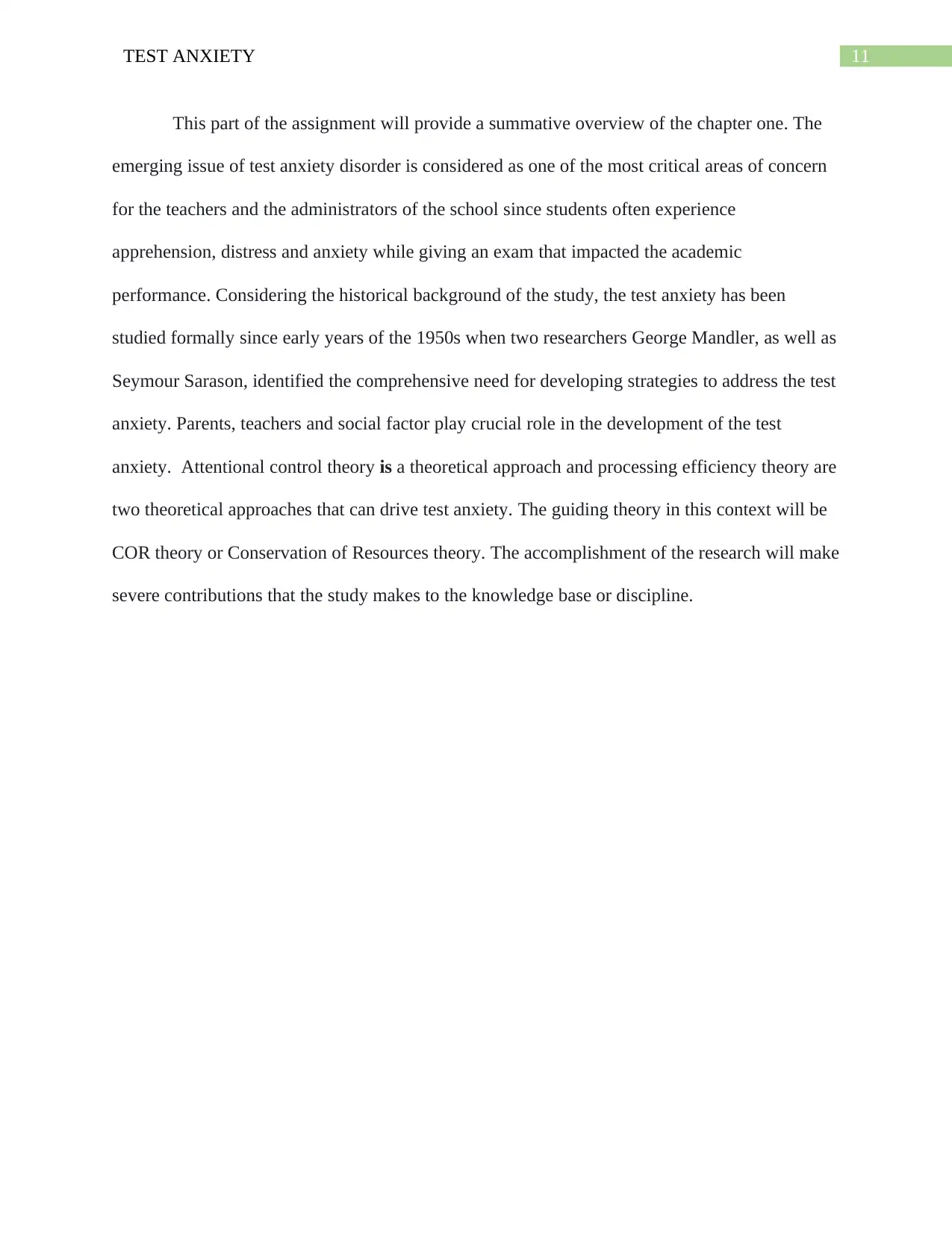
11TEST ANXIETY
This part of the assignment will provide a summative overview of the chapter one. The
emerging issue of test anxiety disorder is considered as one of the most critical areas of concern
for the teachers and the administrators of the school since students often experience
apprehension, distress and anxiety while giving an exam that impacted the academic
performance. Considering the historical background of the study, the test anxiety has been
studied formally since early years of the 1950s when two researchers George Mandler, as well as
Seymour Sarason, identified the comprehensive need for developing strategies to address the test
anxiety. Parents, teachers and social factor play crucial role in the development of the test
anxiety. Attentional control theory is a theoretical approach and processing efficiency theory are
two theoretical approaches that can drive test anxiety. The guiding theory in this context will be
COR theory or Conservation of Resources theory. The accomplishment of the research will make
severe contributions that the study makes to the knowledge base or discipline.
This part of the assignment will provide a summative overview of the chapter one. The
emerging issue of test anxiety disorder is considered as one of the most critical areas of concern
for the teachers and the administrators of the school since students often experience
apprehension, distress and anxiety while giving an exam that impacted the academic
performance. Considering the historical background of the study, the test anxiety has been
studied formally since early years of the 1950s when two researchers George Mandler, as well as
Seymour Sarason, identified the comprehensive need for developing strategies to address the test
anxiety. Parents, teachers and social factor play crucial role in the development of the test
anxiety. Attentional control theory is a theoretical approach and processing efficiency theory are
two theoretical approaches that can drive test anxiety. The guiding theory in this context will be
COR theory or Conservation of Resources theory. The accomplishment of the research will make
severe contributions that the study makes to the knowledge base or discipline.
⊘ This is a preview!⊘
Do you want full access?
Subscribe today to unlock all pages.

Trusted by 1+ million students worldwide
1 out of 16
Related Documents
Your All-in-One AI-Powered Toolkit for Academic Success.
+13062052269
info@desklib.com
Available 24*7 on WhatsApp / Email
![[object Object]](/_next/static/media/star-bottom.7253800d.svg)
Unlock your academic potential
Copyright © 2020–2025 A2Z Services. All Rights Reserved. Developed and managed by ZUCOL.





